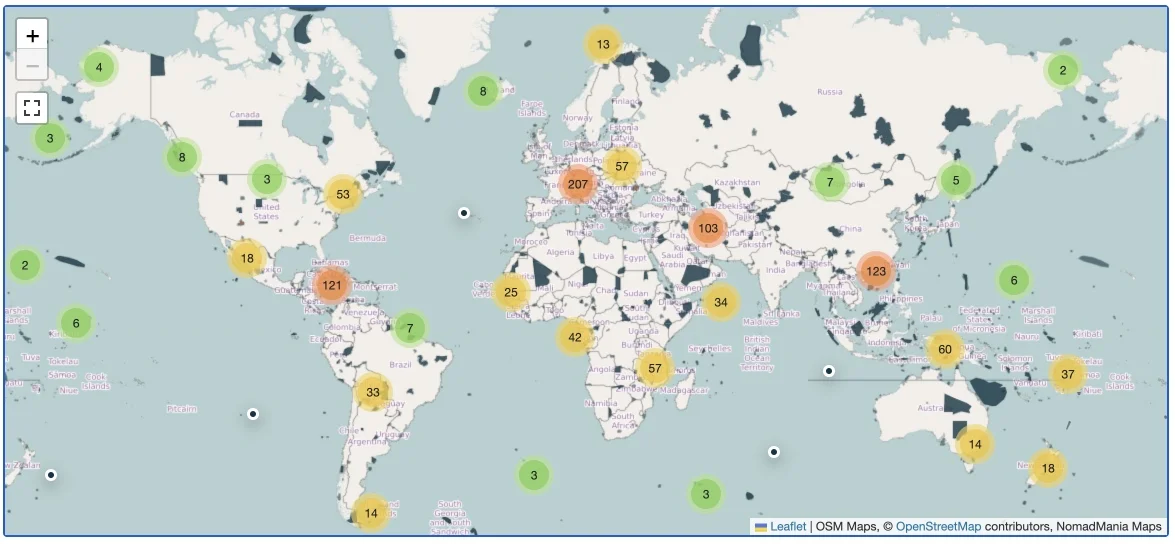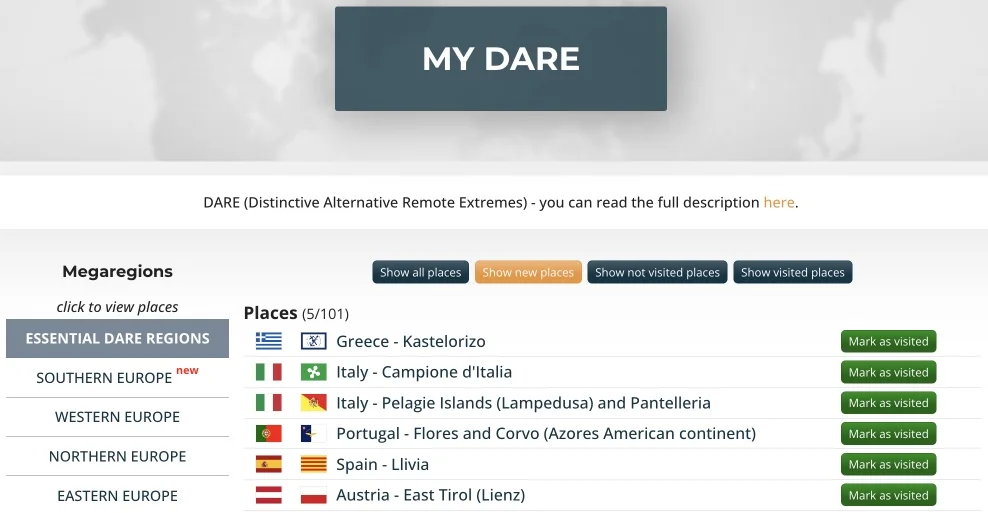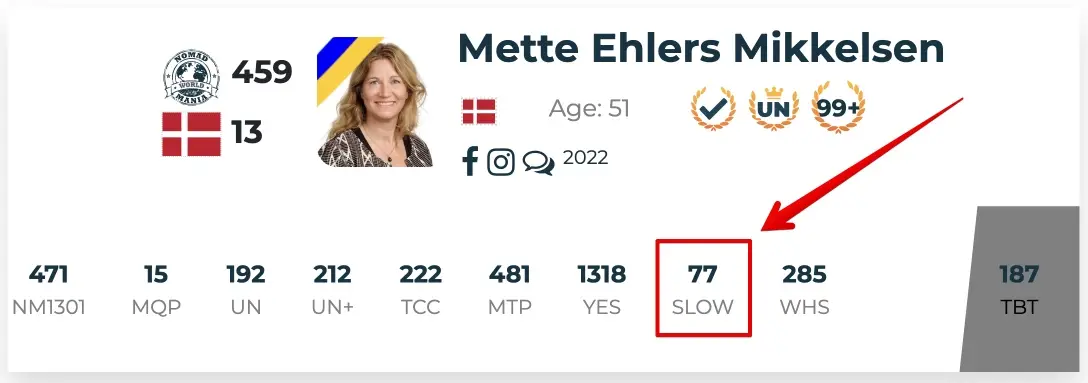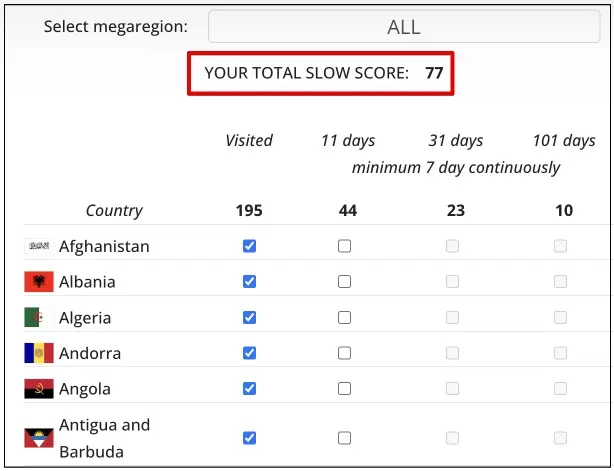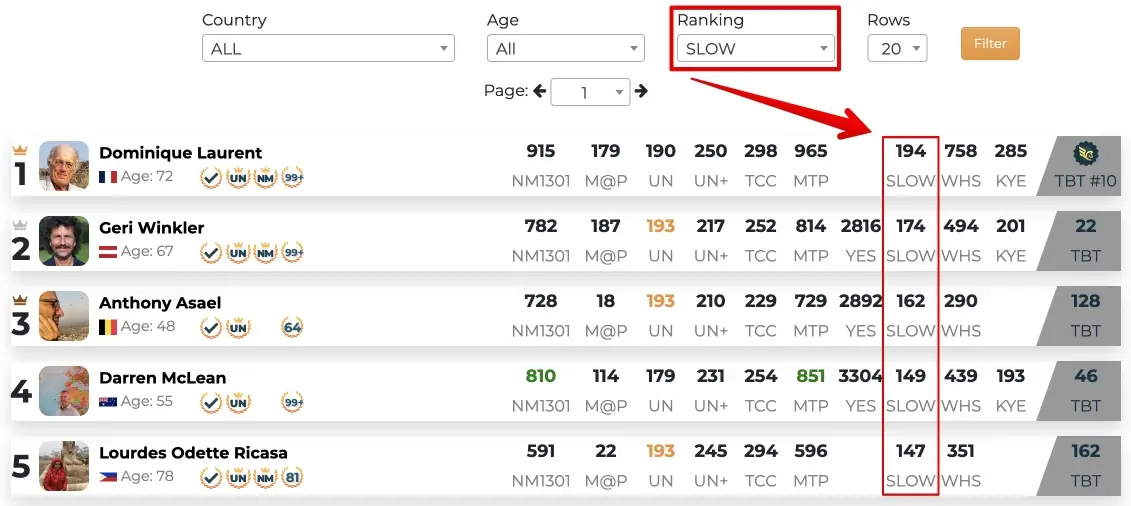Lists and Regions
Our unique positioning is that we approach the world and travel beyond a conventional division into continents and countries. We aim to go deeper and further. Thus we decided to divide the world into regions which in our opinion is a better approach to understand and explore our Planet.
Besides that we are real geeks in terms of various lists. Here are a few explanations below.
Our Masterlist of 1301 regions
Our Masterlist is made up of 1301 regions. We divide countries based on 5 Criteria:
- Territory (Size)
- Population
- Cultural Importance (World Heritage) and Cultural Diversity
- Economic Significance
- Tourist Appeal (based on tourist arrivals)
We then seek to divide each country in regions relative to other countries, so that our list of regions is rational and each country gets its relative worth in terms of regions. There are some exceptions for ethnically divided nations (such as Bosnia and Herzegovina) or for small island nations (such as Micronesia). We believe that a total number of about 1,300 regions is optimal – big enough to be challenging, small enough to be achievable.
In 2022 we did some changes to our regions list. Read the details here.
Visit Guidelines
In order for a visit to qualify as valid, a ‘minimal’ visit is required. However, in the spirit of real travel, NomadMania would consider that good visits should be the aim of travellers. Read the full visit guidelines here.
Verification Explained
The verification system is our way of ensuring that travellers’ claims of their regions and countries visited are true. While we accept our members’ claims, experience has shown that certain people exaggerate their travels, either deliberately or through haste and error.
There are three levels of verification: UN countries, NM regions and Supreme verification.
In all cases, a random sample of countries/regions is given, and the traveller must prove a visit, ideally through visas/stamps, boarding passes, bills and, in certain cases, photographs. Given the wide variety of profiles, the process is adapted to the traveller in question.
Travellers who pass the verification get a badge next to their profile.
Read more about each level of verification here.
DARE (Distinctive Alternative Remote Extremes)
DARE is a novel list that will hopefully bring some new interest in the travel community and encourage travelers to go further – when this becomes possible again.
The idea is that while our NomadMania 1301 Masterlist provides a solid division of the world’s countries, DARE serves as a much more fluid list with all sorts of significant oddities and out-of-the-way places that a traveler could be striving for, including islands, exclaves, geographical anomalies, and some major micronations too.
How is DARE conceptualized?
We start with the esteemed MTP list, which for years has served as a basis for many in the travel community. We take away all regions that link directly to NomadMania regions and then look at those ‘additional’ regions – mainly obscure islands – that have become the talk of the travel community for years.
Our reasoning is simple – if Salas y Gomez or Trinidade and Martim Vaz are worthy of a visit, then why not Miangas island? Never heard of Miangas? Now, with DARE, you have!
Check out all Distinctive Alternative Remote Extremes here.
TBT (The Biggest Travellers Ranking)
TBT (The Biggest Travellers) is a cumulative score of all criteria which we believe is a fair indication of the world’s biggest travellers. It is calculated as a percentage of the total score of the following:
NomadMania Masterlist 1301: 20%
DARE: 20%
SLOW: 15%
YES: 5% (reverse score is best, calculated in bands: 1-750: 5, 751-1500:4, 1501-2500:3, 2501-3500: 2, 3501-4500: 1, 4500+ : 0)
UN: 2%
UN+ : 1%
TCC: 1%
CHAD: 1%
KYE: 5%
Milestones: 5%
WHS: 10 %
Top of the Tops (Series): 5%
All Series Cumulative Score: 5%
Border Series: 1%
World Cities Series: 1%
World of Nature Series: 1%
Experiences Series: 1%
Indigenous Peoples Series: 1%
Travellers with less than 135 UN countries visited are not included in the TBT ranking.
To the total score above, we add the following:
a. one point is added to the travellers who have been verified for NomadMania regions;
b. one point is added to travellers who have at least 100 achievement badges;
c. one point is added to travellers who have a Top 30 entry in the statistics for overall regions visited or new regions visited in one of the previous two calendar years (for 2024, that is 2022 and 2023);
d. Two points are added to the travellers who have passed the rigorous TBT verification and have been awarded their TBT badge – this verification can include any of the lists that form part of the TBT. Note that this verification is by invitation only, and generally includes only those with the highest placings in the TBT ranking.
YES (Years Elapsed Since List)
One issue which our lists have not covered is the dynamism of travel. Have you travelled recently or a long time ago? This is where we bring in the YES list, which stands for ‘Years Elapsed Since’.
The list considers countries only, not regions, and we take 196 countries (193 Un Countries and Palestine, Taiwan and Kosovo). If you have completed your year of visit to a country (which is best done through My Trips, where you create a specific trip with clear dates), your YES will be automatically calculated.
You can also add the last year of your visit to a particular region on My Regions page.
If you visited the country in the current calendar year, your score is 0. We give you a ‘gift’ of the previous calendar year too – your score is 0 for any country visited in the previous calendar yes. Then, say you visited Guyana in 2021, which is now 2 years back from 2023: your score is 2. If your last visit to Tonga was in 2003, and we are in 2023, your score is 20.
If you have never visited a country, the score is your age – it is the number of years elapsed since you last visited, in this case, never, which is your years on the planet. Calculate all 196 scores and you get the total YES score. The lower score is the ‘best’ in the sense that it shows you are actively visiting countries closer to the current time.
We won’t calculate YES scores for people under 20 years old as their scores would be rather low based on their young age. We are also not listing ‘scores’ above 4,000 for this measure.
For travellers who do not use ‘My Trips’, we currently don’t have precise information on the last year of travel to a country, so we use an algorithm as follows:
Aged 20: Age for non visited countries + 10% of age for each visited country
Aged 21: Age for non visited countries + 10.5% of age for each visited country
Aged 22: Age for non visited countries + 11% of age for each visited country
i.e. the percentage will be half of the age as the age goes up
…
Aged 80: Age for non visited countries + 40% of age for each visited country
We will work to as soon as possible create a list where you can clearly note your last year of visit to a country.
SLOW list
For a long time, travel lists such as the Master Ranking of NomadMania have been considered as promoting more superficial, quick trips that prioritise quantity over quality and promote a selfish, ego-boosting style of travel. As NomadMania strives to provide a host of very different ways of seeing travel, in line with our commitment to sustainability, we are launching our SLOW travel listing.
It is our hope that this new way of considering travel will encourage our community to opt for travelling at a slower pace, at least to a certain extent. By rewarding travellers who immerse themselves in a country’s culture over an extended period, we hope to inspire a deeper appreciation for meaningful travel experiences.
We would especially like to thank our friend and UN Master from Denmark Henrik Jeppesen who was the one to initiate the idea of a way to focus on slow travel.
Let’s explore how the SLOW list works and the positive impact it has on rankings and scores.
The SLOW List Explained
The SLOW list focuses on countries rather than NomadMania regions, encompassing 196 countries (including UN 193, Taiwan, Palestine, and Kosovo). We exclude the Vatican due to the impracticality of an extended stay there. We offer three variations of the SLOW list: SLOW11, SLOW31, and SLOW101, denoting the number of days spent in a country overall.
To be eligible to ‘claim’ a country as ‘slow visited’ for ANY of the 3 lists, you must have spent 7 days continuously within a country on one of your trips there. We will accept a few hours border crossings as ‘continuous’ if it is an isolated event and doesn’t include an overnight. For example, if you spend 9 days in Slovakia but go across to Austria for two hours on Day 5, this still counts as 9 days in Slovakia. We leave this to a traveller’s best judgement.
Understanding the SLOW List
To illustrate how the SLOW list functions, let’s consider a few examples.
Suppose you have visited Oman four times, spending the following number of days on each trip:
- Trip 1: 3 days
- Trip 2: 17 days
- Trip 3: 6 days
- Trip 4: 9 days
The total number of days is 35, with a continuous 7-day period observed during the second and fourth trip. Therefore, you can claim Oman on both the SLOW11 and SLOW31 lists.
Now, let’s say you have visited Guyana five times, spending the following number of days on each trip:
- Trip 1: 5 days
- Trip 2: 2 days
- Trip 3: 4 days
- Trip 4: 6 days
- Trip 5: 2 days
The total number of days is 19, but you haven’t spent a minimum of 7 continuous days in Guyana. Hence, you are not eligible to claim Guyana on any of the SLOW lists.
Continuing with the examples, imagine you have visited Laos once and spent 12 days there. Since you have more than 11 days, including a minimum of 7 continuous days, you can claim SLOW11 for Laos.
Effect on Rankings and Total Scores
Once you have examined all 3 SLOW lists, your TOTAL SLOW is an aggregate of SLOW11, SLOW31 AND SLOW101. This is the number that will be presented as part of your profile under your SLOW score.
SLOW list is also available in our Master Ranking.
NomadMania will incorporate the SLOW score into the criteria for determining The Biggest Travellers (TBT) rankings. By acknowledging the significance of slow travel, we aim to celebrate and highlight those who prioritise meaningful connections and immerse themselves in the destinations they visit.
Embrace the joy of slow travel, and let the SLOW list guide you towards enriching adventures around the world.


